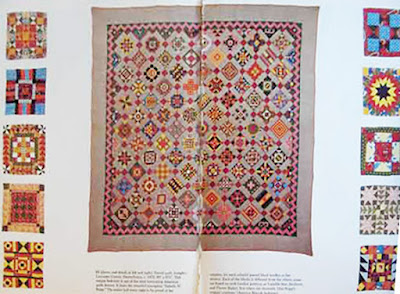Fanny Shenk Bucher Snyder's diamond sampler quilt
This pink extravaganza has the inked initials H.W. and the date 1860 on the front and on the back F.S.B in embroidery.
Inked block near the center
The quilt is often shown with the initials going sideways but
the above photo may be the way it was intended to be viewed.
The quilt has been published several times. Patricia T. Herr's 2000 book Quilting Traditions: Pieces from the Past about the quilts of Lancaster County, Pennsylvania features a large photo on the last page. Fanny's given name was Veronica S. Bucher, born October 7, 1841, died December 24, 1910. She was named Veronica for a grandmother.
There's a date and Fanny's maiden initials on the back indicating it was made before her marriage (eldest daughter Barbara was born in 1862.) But I spent some time considering that date of 1860. Could it be that early? Or was that date commemorative? Or perhaps cut from another older piece of needlework?
A piece of double pink calico with a bolt label from
M.C.D. Borden & Sons,
(American Printing Company in Fall River, Massachusetts)
Why does the date of 1860 make me so suspicious?
First of all it is so pink.
There were plenty of double pink fabrics around in 1860 but it's the pink attitude.
My observation in dating pink quilts....The more pink in the quilt the closer to 1900. It's just not a look you see in 1860.
Second: there are undated similar quilts from the Lancaster County neighborhood that are estimated to have been made at a later date. Trish Herr showed two quilts by Fanny's daughter Barbara Bucher Snyder Stoner (1862-1922)
Barbara Snyder Stoner's Sampler
Estimated date circa 1880
Also very pink.
And then there is this pink twin to Fanny's diamond sampler by an
unknown maker.
Barbara's square block sampler also has a twin
Sampler stenciled "Salinda W. Rupp", 88" square
Salinda Hoffman Rupp (1844-1920) was also from Lancaster County, buried in the Muddy Creek Cemetery in Denver, Pennsylvania with husband Franklin Rupp. Her sashing strips are a brown print that looks to have always been brown.
It was first published in Robert Bishop & Patricia Coblentz's 1975 book New Discoveries in American Quilts. Dealers America Hurrah supplied the photo. The date was estimated to be about 1870 and detail pictures of the blocks show Prussian blues and madder prints that are consistent with that date.
As you can imagine these samplers of small intricate blocks would have taken a long time to finish. I'm still a little confused about that 1860 date, but I can't come up with any real evidence to argue against it.
It is fun, however, to look at these unusual and very busy samplers. Here are some less ambitious relatives---all look to date from the last quarter of the 19th century.
From Stella Rubin's Inventory
Collection of the Speed Museum in Kentucky
Los Angeles County Museum of Art
The perfect use for leftover blocks.














Whew that is a lot of pink.
ReplyDeleteThis comment has been removed by the author.
ReplyDeleteI made that Salinda Rupp quilt before it was patterned, and called it Pennsylvania Plenty. We did it as a group and the mathematician of our group drew up the majority of the blocks. Those are some fun and quirky quilts!
ReplyDeleteLori You remind me that there is also a pattern book for the Salinda Rupp quilt called Nearly Insane.
ReplyDeleteLovely pink attitude and inspiration for a good way to use scraps and
ReplyDeleteleftovers.
Thanks for sharing.
I love samplers, the more unusual the better. Thanks for showing these.
ReplyDelete(Isn't that quirky one the inspiration for Temecula Quilt Co's current sew-along?)
Less ambitious relatives...lol
ReplyDeleteThis comment has been removed by the author.
ReplyDeleteI came across an all pink quilt the seller claims is late 1800s, because the prints are double pink, but it just doesn't look it to me. Can I post a pic?
ReplyDelete